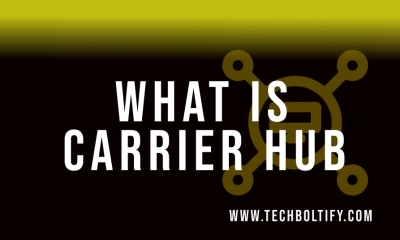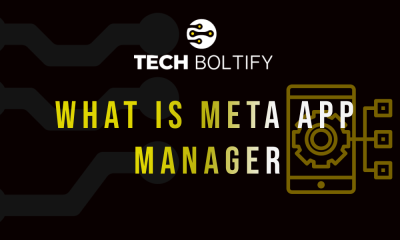Tech
How to Fix Toshiba TV Not Responding to Remote – Step-by-Step Guide
There might be many reasons that may cause your Toshiba TV remote not to respond. Hence, we have many possible solutions in today’s guide. We’ll discuss all the potential solutions to fix the remote problems that faulty batteries, system glitches, or interference of some other devices to the system may cause. So read the complete article for detailed information.
Reasons for Toshiba TV Not Responding To the Remote
Many reasons can cause a Toshiba TV to stop responding to the remote control, these common causes are as follows:
- Low or drained batteries in the remote
- Interruptions because of other devices
- A glitch in a TV or remote system
- Connection error
- Any issue in the TV’s IR
These are some of the common errors that might cause the response of the remote. What you need to do is understand the root of the problem and fix it accordingly without wasting time. Now let’s look at the possible solutions to fix these common issues.
Step-by-Step Guide To Fix Toshiba TV No Responsiveness
Step 1: Power Cycle The Toshiba TV and Remote Control
To resolve the minor glitches in the system, power cycling is the most common and easy solution. It helps refresh the system and restore the residual power from the TV and remote. It also helps the system to return to normal functionality. For this purpose, please follow these steps:
- Turn off your TV and unplug the power outlet.
- Remove the power batteries from the remote.
- Press and hold the power button of the remote for 10 – 15 seconds.
- Then release the button and wait for 2-3 minutes.
- Press all the buttons of the remote one by one to ensure that there are no stuck buttons.
- Then reinsert the batteries into the remote.
- Plug the TV in again and turn it on manually.
By following this process, you will see the red light of the remote in blinking mode. It means
Your TV’s power cycling processing is complete and is ready to use the remote again. If it will not help in fixation then move to the other step.
Step 2: Clean The Battery Compartment And Replace The Batteries
Sometimes, some corroded battery terminal or dirt particles could prevent the remote from functioning properly. It is necessary to compartment and clean it if required. How you can do it by following these small steps:
- Remove the batteries from the device(remote).
- Check the terminal points, if any corrosion persists.
- Use a soft brush or a soft damp cloth to clean the terminal parts.
- Wait to dry it naturally.
- Then insert the fresh power batteries and use to remote again.
Step 3: Unpair The Remote for Repairing
If you paired your Toshiba TV via Bluetooth or RF, repairing might be the solution for the connectivity issue. Please follow these general steps to fix the not responding issue.
- Unpair the remote, the way mentioned on the TV’s manual guide or setting.
- Restart the TV after unpairing.
- Repair the remote by pressing the pairing button (if applicable)
- Follow the on-screen instructions.
- Once paring is done, reuse the remote to check whether the issue is resolved or not.
Step 4: Check For The Interference From Other Devices
It happens sometimes that interference from other devices and remote controllers can cause the issue for the Toshiba TV remote not to respond. If it happens, use these steps to resolve the issue.
- Check the other device nearby where Toshiba TV.
- Check the remote’s stuck buttons or any other malfunctioning controls.
- Turn off the interfering devices.
- Now recheck whether your Toshiba TV remote is responding or not.
Step 5: Restart The Toshiba TV To Factory Setting
If you tried all the above-mentioned solutions but are unable to fix the Toshiba TV not responding, you need to factory reset the TV to remove all the glitches or bugs in the system.
This will reset your TV and remove all the customized settings you’ve done so far.
- Go to the Settings menu on your TV.
- Navigate to the Device or System Device settings options.
- Choose the Reset default or factory reset option.
- Select any of the options. Confirm your choice.
- The system will reset soon.
After resetting the Toshiba TV, if the issue persists, then you must contact customer support or consider another remote controller.
Step 6: Alternatives to Fix The Toshiba TV Not Responding
You can choose other alternative methods to resolve the Toshiba TV not responding issue.
Use A Mobile App
There are many smartphone apps for Android and IOS devices for controlling Toshiba TV. What you need to do is:
- To install the Toshiba TV remote app from Play or Apple Store on the phone.
- Connect the phone with the same WiFi network as the TV.
- Open the app and select the list available for devices.
- Use the on-screen instructions to operate the TV.
Use A Universal Remote For Toshiba TV
A universal remote can be used for multiple devices, these are useful in case of the above-mentioned issues. These remotes have advanced settings to use accordingly.
Final Verdict
So, you see all the methods and possible solutions that can help you to fix the Toshiba TV not responding issues. These methods will help you to troubleshoot and resolve the issues related to remotes and TVs. If you find that the issue is still not fixed, contact customer support and they will resolve the hardware-related issues to fix it accordingly.
FAQs For Toshiba TV Not Responding To Remote Problem
Q: Why won’t my Toshiba TV work with the remote control?
Typical causes include depleted batteries, interference from other devices, malfunctions in the system, or problems connecting smart remotes or Bluetooth devices.
Q: Without a remote, how can I use my Toshiba TV?
As an alternative, you can use a universal remote or download the Toshiba TV Remote app for iOS or Android.
Q. How do I reset the remote control on my Toshiba TV?
Take out the batteries, hold down the power button for ten to fifteen seconds, put the batteries back in, and try using the remote control once more.
Tech
The Complete Guide to AI Comment Classification: Spam, Slander, Objections & Buyers
Meta ad comment sections are unpredictable environments. They attract a mix of users—some legitimate, some harmful, some automated, and some simply confused. For years, brands relied on manual review or simple keyword filters, but modern comment ecosystems require more advanced systems.
Enter AI comment classification.
AI classification engines evaluate language patterns, sentiment, intention, and user context. They categorize comments instantly so brands can prioritize what matters and protect what’s most important: trust, clarity, and conversion.
The Four Major Comment Types
1. Spam & Bots
These include cryptocurrency scams, fake giveaways, bot‑generated comments, and low‑value promotional content. Spam misleads users and diminishes ad quality. AI detects suspicious phrasing, repetitive patterns, and known spam signatures.
2. Toxicity & Slander
These comments contain profanity, hostility, misinformation, or attempts to damage your brand. Left unmoderated, they erode trust and push warm buyers away. AI identifies sentiment, aggression, and unsafe topics with high accuracy.
3. Buyer Questions & Objections
These represent your highest-value engagement. Users ask about pricing, delivery, sizing, guarantees, features, or compatibility. Fast response times dramatically increase conversion likelihood. AI ensures instant clarification.
4. Warm Leads Ready to Convert
Some comments come from buyers expressing clear intent—“I want this,” “How do I order?”, or “Where do I sign up?” AI recognizes purchase language and moves these users to the top of the priority stack.
Why AI Is Necessary Today
Keyword lists fail because modern users express intent in creative, informal, or misspelled ways. AI models understand context and adapt to evolving language trends. They learn patterns of deception, sentiment clues, emotional cues, and buyer intent signals.
AI classification reduces the burden on marketing teams and ensures consistent and scalable comment management.
How Classification Improves Paid Media Performance
• Clean threads improve brand perception
• Toxicity removal increases user trust
• Fast responses increase activation rate
• Meta rewards high-quality engagement
• Sales teams receive properly filtered leads
For brands spending heavily on paid social, classification isn’t optional—it’s foundational.
Tech
How To Bridge Front-End Design And Backend Functionality With Smarter API Strategy
Introduction: Building More Than Just Screens
We’ve all seen apps that look sharp but crumble the moment users push beyond the basics. A flawless interface without strong connections underneath is like a bridge built for looks but not for weight. That’s why APIs sit at the heart of modern software. They don’t just move data; they set the rules for how design and logic cooperate. When APIs are clear, tested, and secure, the front-end feels smooth, and the backend stays reliable.
The reality is that designing those connections isn’t just “coding.” It’s product thinking. Developers have to consider user flows, performance, and future scale. It’s about more than endpoints; it’s about creating a system that’s flexible yet stable. That mindset also means knowing when to bring in a full-stack team that already has the tools, patterns, and experience to move fast without cutting corners.
Here’s where you should check Uruit’s website. By focusing on robust API strategy and integration, teams gain the edge to deliver features user’s trust. In this article, we’ll unpack how to think like a product engineer, why APIs are the real bridge between design and functionality, and when it makes sense to call in expert support for secure, scalable development.
How To Define An API Strategy That Supports Product Goals
You need an API plan tied to what the product must do. Start with user journeys and map data needs. Keep endpoints small and predictable. Use versioning from day one so changes don’t break clients. Document behavior clearly and keep examples short. Design for errors — clients will expect consistent messages and codes. Build simple contracts that both front-end and backend teams agree on. Run small integration tests that mimic real flows, not just happy paths. Automate tests and include them in CI. Keep latency in mind; slow APIs kill UX. Think about security early: auth, rate limits, and input checks. Monitor the API in production and set alerts for key failures. Iterate the API based on real use, not guesses. Keep backward compatibility where possible. Make the API easy to mock for front-end developers. Celebrate small wins when a new endpoint behaves as promised.
- Map user journeys to API endpoints.
- Use semantic versioning for breaking changes.
- Provide simple, copy-paste examples for developers.
- Automate integration tests in CI.
- Monitor response times and error rates.
What To Do When Front-End and Backend Teams Don’t Speak the Same Language
It happens. Designers think in pixels, engineers think in data. Your job is to make a shared language. Start by writing small API contracts in plain text. Run a short workshop to align on fields, types, and error handling. Give front-end teams mocked endpoints to work against while the backend is built. Use contract tests to ensure the real API matches the mock. Keep communication frequent and focused — short syncs beat long meetings. Share acceptance criteria for features in user-story form. Track integration issues in a single list so nothing gets lost. If you find repeated mismatches, freeze the contract and iterate carefully. Teach both teams basic testing so they can verify work quickly. Keep the feedback loop tight and friendly; blame only the problem, not people.
- Create plain-language API contracts.
- Provide mocked endpoints for front-end use.
- Contract tests between teams.
- Hold short, recurring integration syncs.
- Keep a single backlog for integration bugs.
Why You Should Think Like a Product Engineer, Not Just A Coder
Thinking like a product engineer changes priorities. You care about outcomes: conversion, help clicks, retention. That shifts API choices — you favor reliability and clear errors over fancy features. You design endpoints for real flows, not theoretical ones. You measure impact: did a change reduce load time or drop errors? You plan rollouts that let you test with a small cohort first. You treat security, observability, and recoverability as product features. You ask hard questions: what happens if this service fails? How will the UI show partial data? You choose trade-offs that help users, not just satisfy a design spec. That mindset also tells you when to hire outside help: when speed, scale, or compliance exceeds your team’s current reach. A partner can bring patterns, reusable components, and a proven process to get you shipping faster with less risk.
- Prioritize outcomes over features.
- Measure the user impact of API changes.
- Treat observability and recovery as product features.
- Plan gradual rollouts and feature flags.
- Know when to add external expertise.
How We Help and What to Do Next
We stand with teams that want fewer surprises and faster launches. We help define API strategy, write clear contracts, and build secure, testable endpoints that front-end teams can rely on. We also mentor teams to run their own contract tests and monitoring. If you want a quick start, map one critical user flow, and we’ll help you design the API contract for it. If you prefer to scale, we can join as an extended team and help ship several flows in parallel. We stick to plain language, measurable goals, and steady progress.
- Pick one key user flow to stabilize first.
- Create a minimal API contract and mock it.
- Add contract tests and CI guards.
- Monitor once live and iterate weekly.
- Consider partnering for larger-scale or compliance needs.
Ready To Move Forward?
We’re ready to work with you to make design and engineering speak the same language. Let’s focus on one flow, make it reliable, and then expand. You’ll get fewer regressions, faster sprints, and happier users. If you want to reduce risk and ship with confidence, reach out, and we’ll map the first steps together.
Tech
Which SEO Services Are Actually Worth Outsourcing? Let’s Talk Real-World Wins
Okay, raise your hand if you thought SEO just meant stuffing keywords into blog posts and calling it a day. (Don’t worry, we’ve all been there.) Running a business comes with enough hats already, and when it comes to digital stuff, there’s only so much you can do on your own before your brain starts melting. The world of SEO moves quick, gets technical fast, and—honestly—a lot of it’s best left to the pros. Not everything, but definitely more than people expect. So, let’s go through a few of those SEO services you might want to hand off if you’re looking to get found by the right folks, minus the headaches.
Technical SEO—More Than Just Fancy Talk
If you’ve ever seen a message saying your website’s “not secure” or it takes ages to load, yeah, that’s technical SEO waving a big red flag. This stuff lives under the hood: page speed, mobile-friendliness, fixing broken links, and getting those little schema markup things in place so search engines understand what the heck your pages are about.
You could spend hours (days) learning this on YouTube or DIY blogs, but hiring a specialist—someone who does this all day—saves you a load of stress and guesswork. Sites like Search Engine Journal dig into why outsourcing makes sense, and honestly, after one too many late-night plugin disasters, I’m convinced.
Content Writing and On-Page Optimization (Because Words Matter)
Let’s not dance around it: great content still rules. But search-friendly content is a different beast. It needs to hit the right length, work in keywords naturally, answer genuine questions, and actually keep visitors hooked. Outsourcing writing, especially to someone who actually cares about your brand’s tone, is worth it for most of us.
On-page SEO, which is tweaking all those little details like titles, descriptions, internal links, and image alt text, is a time-eater. It’s simple once you get the hang of it, but when you’re trying to grow, outsourcing makes the most sense.
Link Building—Trickier Than It Looks
Here’s where things get a bit spicy. Backlinks are essential, but earning good ones (not spammy or shady stuff) takes relationship-building, tons of outreach, and real patience. You can spend all month sending emails hoping someone will give your guide a shout-out, or you can just hire folks with connections and a process. Just watch out for anyone promising “hundreds of links for dirt cheap”—that’s usually a shortcut to trouble.
Local SEO—Getting Seen in Your Own Backyard
Ever tried showing up for “pizza near me” only to find yourself on page 7? Local SEO isn’t magic, but it takes a special touch: optimizing your Google Business Profile, gathering reviews, and making sure your info matches everywhere. It’s honestly a job in itself, and most small teams find it way easier to have a local SEO pro jump in a few hours a month.
Reporting and Analytics—Don’t Go Blind
Last, don’t skip out on real reporting. If nobody’s tracking what’s working—and what’s not—you’re just flying blind. Outsourced SEO pros come armed with tools and real insights, so you can see if your money’s going somewhere or just swirling down the drain.
Wrapping Up—Be Realistic, Outsource Smarter
You’re good at what you do, but SEO is more like ten jobs rolled into one. Outsource the parts that zap your time or make your brain itch, and keep what you enjoy. Focus on the wins (more leads, higher rankings, fewer headaches), and watch your business get the attention it deserves.
-
Tech1 year ago
AI and Freight Management
-

 Tech2 years ago
Tech2 years agoLPPe Service Android App and its Functions – How to Remove it
-

 Tech1 year ago
Tech1 year agoWhat is a Permission Controller – Control Manager Notifications
-

 Tech2 years ago
Tech2 years agoWhat is Device Keystring App On Android
-

 Tech2 years ago
Tech2 years agoWhat is Carrier Hub – How to Resolve Processing Requests Issues
-

 Tech2 years ago
Tech2 years agoWhat is Summit IMS Service – How to Stop Syncing on Your Android Device
-

 Tech2 years ago
Tech2 years agoMeta App Manager – What is Meta App Installer
-

 Tech2 years ago
Tech2 years agoWhat is Cameralyzer Samsung – How to Fix or Uninstall Cameralyzer on Android

